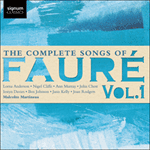This is a song of transition as Fauré’s early romance style begins to merge with the greater depths of the mélodie. The music seems influenced by
Soirée en mer (1862), a Victor Hugo setting by Fauré’s teacher, Camille Saint-Saëns.
Les matelots is more vigorous, but both songs are powered by undulating triplets which reflect the fathomless motion of the sea. The subtle, and sometimes unexpected, harmonic shadings in these restless quavers enliven the potential monotony of the accompaniment; in this roving harmony we can savour the sailors’ love of adventurous exploration. As each strophe progresses towards its vocal climax the bass line falls in steps, widening the distance between the piano’s left hand and the vocal line. This depicts the breadth of vast nautical horizons with a musical grandeur that effectively outfaces the sentimentality of the text. The poem is from Théophile Gautier’s
Poésies nouvelles (1845). The composer, already merciless in terms of adapting poetry to his musical needs, cuts the second and fourth of Gautier’s strophes.
from notes by Graham Johnson © 2005
Il s’agit d’une mélodie de transition, où le style de romance du Fauré des débuts commence de se mêler aux profondeurs accrues de la mélodie. La musique semble influencée par
Soirée en mer (1862), pièce du professeur de Fauré, Camille Saint-Saëns, sur un poème hugolien.
Les matelots s’avère plus vigoureuse, mais les deux mélodies sont propulsées par des troilets ondoyants, reflet de l’insondable mouvement de la mer. Les nuances harmoniques subtiles, parfois inattendues, de ces croches nerveuses animent la potentielle monotonie de l’accompagnement; cette harmonie vagabonde nous fait savourer l’amour des marins pour l’exploration aventureuse. Lorsque chaque strophe progresse vers son apogée vocal, la ligne de basse descend par degrés, éloignant la main gauche pianistique de la ligne vocale. Ce qui dépeint l’ampleur des vastes horizons nautiques avec un grandiose musical qui résiste efficacement à la sentimentalité du texte. Le poème est extrait des
Poésies nouvelles (1845) de Théophile Gautier. Fauré, déjà impitoyable lorsqu’il s’agissait d’adapter la poésie à ses besoins musicaux, en a retranché les deuxième et quatrième strophes.
extrait des notes rédigées par Graham Johnson © 2005
Français: Hypérion


 Fauré: The Complete Songs, Vol. 1
Fauré: The Complete Songs, Vol. 1
